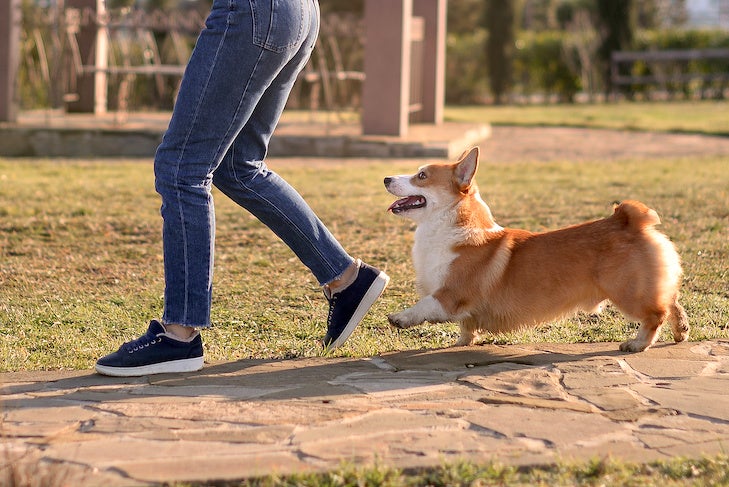
We love spending quality time with our dogs. But there may be days when we wonder, “Why does my dog follow me everywhere?” The answer has to do with their animal instinct, pack mentality, and a few other variables.
Canine companions that follow their humans everywhere are often referred to as “Velcro dogs” because of their desire to be attached to your side. “Dogs are pack animals, and we are their pack,” says Sally Morgan, author and holistic physical therapist for pets and people.
While having your dog follow you everywhere might seem cute and lovable, there are also scientific reasons behind dogs’ clingy behavior. “Young puppies anywhere from birth to 6 months of age can often imprint on their owners and look to them as they would their mother,” says Dr. Rachel Barrack, a licensed veterinarian certified in veterinary acupuncture.
Another reason your dog might stay close to your side is positive reinforcement. “If every time you are with your dog, he gets affection or treats, he’s likely to follow you around more often,” Dr. Barrack says. If you’re flattered by this affection, and reward your dog for being clingy, you’re sending them a message that the behavior is welcome.
Because dogs respond to their owners’ behavior, it’s important to examine your relationship. For example, if your dog sleeps in your bed, you might be creating a dependency and reinforcing their need to be close to you at all times.
Following the Leader
In households consisting of multiple people, there’s a good chance your dog will become fixated on one person in particular. It might be the primary caregiver who provides food and walks, or perhaps it’s the fun-time owner who plays games and hands out endless amounts of treats.
“Look at it from the dog’s point of view,” says Erin Kramer, a professional certified dog trainer and owner of Tug Dogs in Northern California. “You might think you’re the cool one, but the person your dog is attached to is the road to everything wonderful and magical. The focus is on that person because of what they give access to.”
A dog’s life experience before entering your home can play a big part when it comes to being fixated on one person, especially for dogs who have been rescued. What was their life like before they came to live with you? “Those previous experiences have an impact on a dog and can contribute to the lingering fear of abandonment,” says Dr. Barrack.

It’s not uncommon for certain breeds to over-attach to their owners. This includes dogs in the Working Group or Herding Group that are bred to work side-by-side with humans. “It’s a trait that’s prized and bred into their genetic history,” says Kramer.
If your dog is overly attached, it’s important to figure out whether this behavior is part of their personality and breeding, or if something more serious is going on. For example, an older dog may be losing their sight or hearing. As a result, they may become more fearful of the environment and dependent on having you near.
“A dog that suddenly becomes very clingy may be suffering from a physical ailment and keeping you in reach for comfort. A checkup by the veterinarian is a good idea if this happens,” says Dr. Jerry Klein, Chief Veterinary Officer for the AKC.
Velcro Dogs vs. Dogs With Separation Anxiety
Could a dog who is attached to you at the hip be showing signs of separation anxiety? While being a “Velcro dog” and having separation anxiety are both associated with not wanting to be away from an owner, there are some distinct yet subtle differences between these two forms of behavior.
The big difference between separation anxiety and being a Velcro dog is anxiety itself. While Velcro dogs prefer to be glued to their owners, dogs with true separation anxiety actually panic when they’re away from their owners.
Velcro dogs may be more inclined to develop separation anxiety, but it doesn’t automatically mean they will. However, you might wish to address the behavior before it reaches the point where your dog can’t function without you in the picture.
Creating a Healthy Balance
What is best is a dog who loves your attention and being close to you but is fine when you’re not around for a period of time. There are various approaches owners can take to help a dog who exhibits these traits:
- “Bonding with your dog is good for you,” says Dr. Barrack. “Just make sure that in the process you do not limit the dog’s social interactions with other dogs and people.”
- Physical and mental exercise also may encourage a dog to settle down and relax. A dog with too much energy is more likely to be bored and restless – and to follow you.
- Leaving toys and treats near their dog bed can give your dog a place to settle down. Teach the “stay” and “place” commands, and give your dog attention for remaining on the dog bed.
- If there are other adults in your household, have them walk the dog on a regular basis.
- Your dog may lack confidence and stick to you for protection. Encourage them, for short periods of time, to be across the room or in another room.
- Set up rules and stick to them. If you want your dog to stay away from the dinner table or sleep in their own bed every night, work on training your dog to do that. And if you’re having trouble with your pup’s clingy behavior, consider consulting a professional dog trainer.
Many of us get a dog so we will have a constant companion. Your dog deserves your love and attention, and it’s up to you to find a healthy balance for time together and apart.

